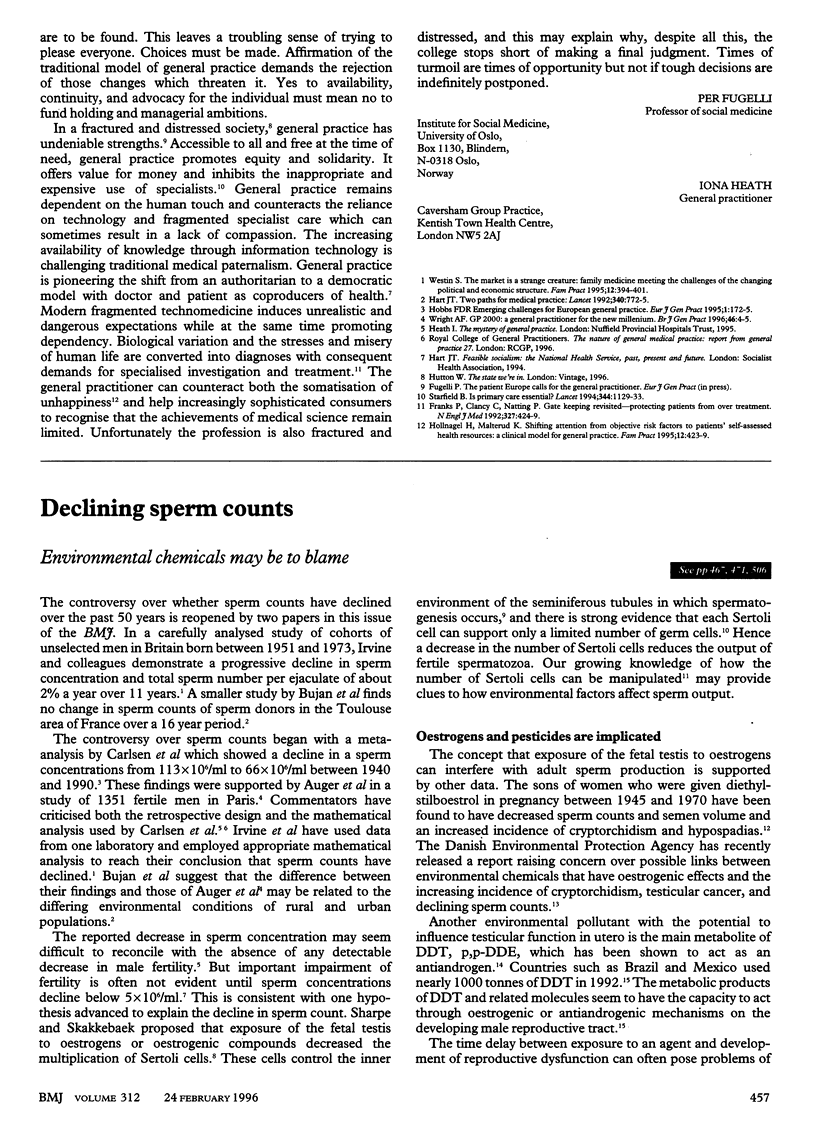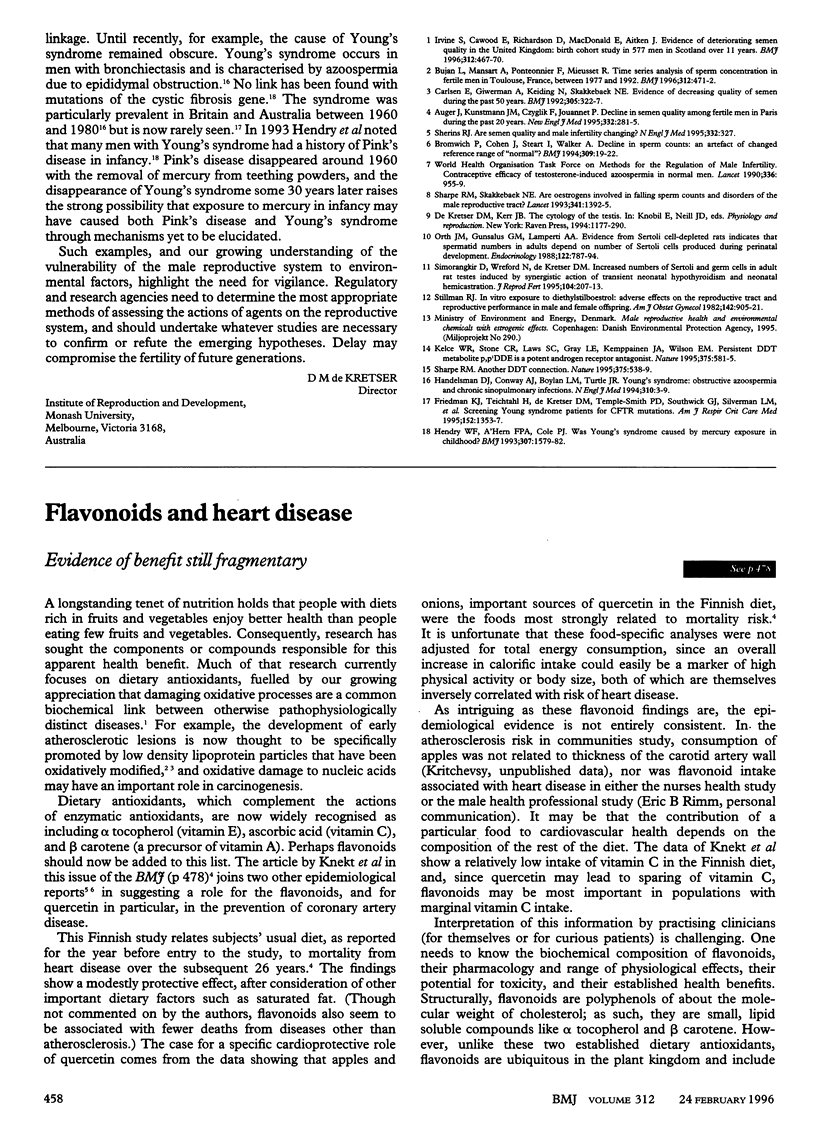Full text
PDF

Selected References
These references are in PubMed. This may not be the complete list of references from this article.
- Auger J., Kunstmann J. M., Czyglik F., Jouannet P. Decline in semen quality among fertile men in Paris during the past 20 years. N Engl J Med. 1995 Feb 2;332(5):281–285. doi: 10.1056/NEJM199502023320501. [DOI] [PubMed] [Google Scholar]
- Bromwich P., Cohen J., Stewart I., Walker A. Decline in sperm counts: an artefact of changed reference range of "normal"? BMJ. 1994 Jul 2;309(6946):19–22. doi: 10.1136/bmj.309.6946.19. [DOI] [PMC free article] [PubMed] [Google Scholar]
- Bujan L., Mansat A., Pontonnier F., Mieusset R. Time series analysis of sperm concentration in fertile men in Toulouse, France between 1977 and 1992. BMJ. 1996 Feb 24;312(7029):471–472. doi: 10.1136/bmj.312.7029.471. [DOI] [PMC free article] [PubMed] [Google Scholar]
- Friedman K. J., Teichtahl H., De Kretser D. M., Temple-Smith P., Southwick G. J., Silverman L. M., Highsmith W. E., Jr, Boucher R. C., Knowles M. R. Screening Young syndrome patients for CFTR mutations. Am J Respir Crit Care Med. 1995 Oct;152(4 Pt 1):1353–1357. doi: 10.1164/ajrccm.152.4.7551394. [DOI] [PubMed] [Google Scholar]
- Hendry W. F., A'Hern R. P., Cole P. J. Was Young's syndrome caused by exposure to mercury in childhood? BMJ. 1993 Dec 18;307(6919):1579–1582. doi: 10.1136/bmj.307.6919.1579. [DOI] [PMC free article] [PubMed] [Google Scholar]
- Irvine S., Cawood E., Richardson D., MacDonald E., Aitken J. Evidence of deteriorating semen quality in the United Kingdom: birth cohort study in 577 men in Scotland over 11 years. BMJ. 1996 Feb 24;312(7029):467–471. doi: 10.1136/bmj.312.7029.467. [DOI] [PMC free article] [PubMed] [Google Scholar]
- Kelce W. R., Stone C. R., Laws S. C., Gray L. E., Kemppainen J. A., Wilson E. M. Persistent DDT metabolite p,p'-DDE is a potent androgen receptor antagonist. Nature. 1995 Jun 15;375(6532):581–585. doi: 10.1038/375581a0. [DOI] [PubMed] [Google Scholar]
- Orth J. M., Gunsalus G. L., Lamperti A. A. Evidence from Sertoli cell-depleted rats indicates that spermatid number in adults depends on numbers of Sertoli cells produced during perinatal development. Endocrinology. 1988 Mar;122(3):787–794. doi: 10.1210/endo-122-3-787. [DOI] [PubMed] [Google Scholar]
- Sharpe R. M. Reproductive biology. Another DDT connection. Nature. 1995 Jun 15;375(6532):538–539. doi: 10.1038/375538a0. [DOI] [PubMed] [Google Scholar]
- Sharpe R. M., Skakkebaek N. E. Are oestrogens involved in falling sperm counts and disorders of the male reproductive tract? Lancet. 1993 May 29;341(8857):1392–1395. doi: 10.1016/0140-6736(93)90953-e. [DOI] [PubMed] [Google Scholar]
- Sherins R. J. Are semen quality and male fertility changing? N Engl J Med. 1995 Feb 2;332(5):327–328. doi: 10.1056/NEJM199502023320510. [DOI] [PubMed] [Google Scholar]
- Simorangkir D. R., de Kretser D. M., Wreford N. G. Increased numbers of Sertoli and germ cells in adult rat testes induced by synergistic action of transient neonatal hypothyroidism and neonatal hemicastration. J Reprod Fertil. 1995 Jul;104(2):207–213. doi: 10.1530/jrf.0.1040207. [DOI] [PubMed] [Google Scholar]
- Stillman R. J. In utero exposure to diethylstilbestrol: adverse effects on the reproductive tract and reproductive performance and male and female offspring. Am J Obstet Gynecol. 1982 Apr 1;142(7):905–921. doi: 10.1016/s0002-9378(16)32540-6. [DOI] [PubMed] [Google Scholar]


